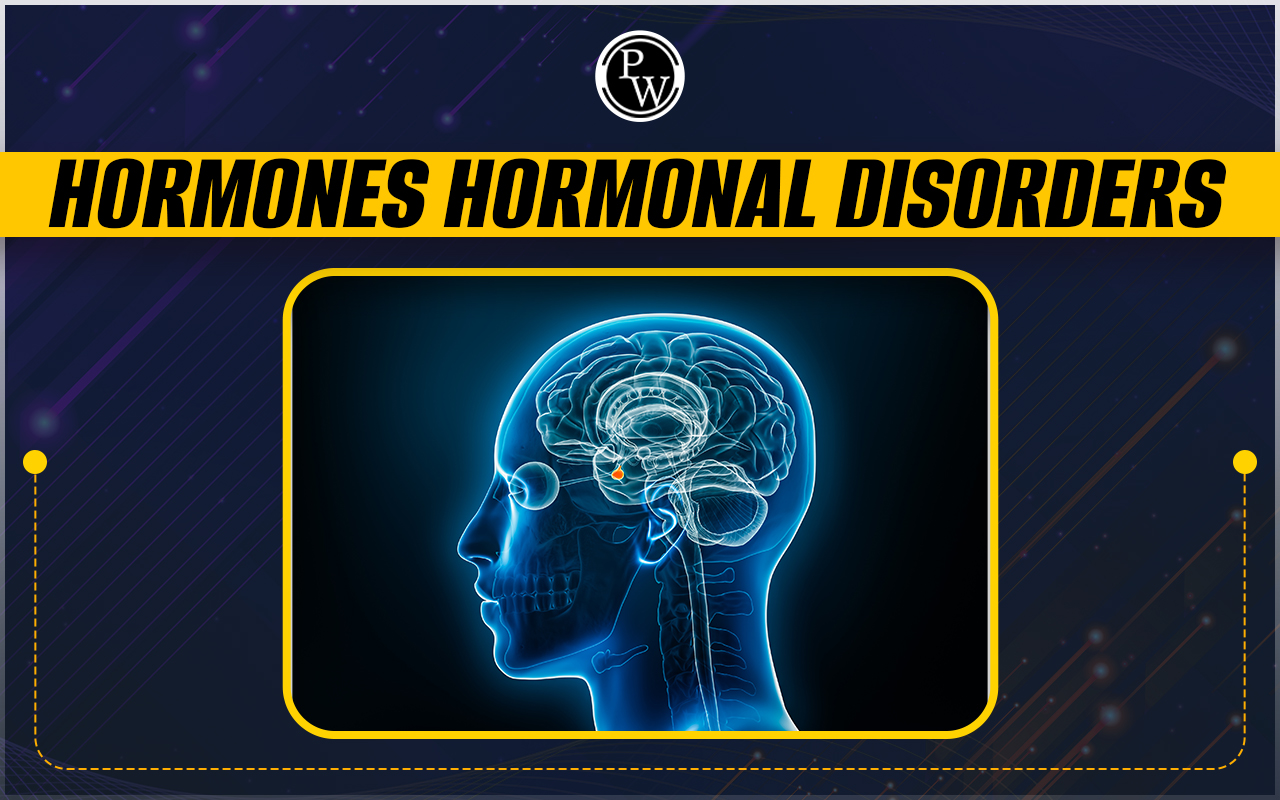

Hormones Hormonal Disorders: Hormones are potent chemicals created in the endocrine glands that go through your circulation, instructing tissues and organs on what to perform. They assist in regulating several vital bodily functions, such as metabolism and reproduction.
A hormonal imbalance occurs when you have an excess or deficit of a particular hormone. Even seemingly little changes might negatively impact your entire body. Your hormone levels may change throughout your lifetime due to normal ageing. However, when your endocrine glands malfunction, other changes take place. A hormonal imbalance can be indicated by a wide range of symptoms, including weight gain and loss. Treatment options exist for many diseases that result in hormonal imbalances. This article will discuss the various hormones, the effect and cause of their imbalances and the treatment options available.Introduction to Hormones
The endocrine system uses hormones to regulate and coordinate your body's internal metabolism, also known as homeostasis, energy level, reproduction, growth and development, and reaction to stress, injury, and environmental influences. Hormones communicate with the skin, muscles, organs, and other tissues through the blood to coordinate various body activities. Hormones are essential for both health and survival. Over 50 hormones in the human body have so far been identified by scientists. The endocrine system comprises most of the tissues in the body (primarily glands) that produce and release hormones. Numerous physiological functions are regulated by hormones, including- Metabolism.
- Mood.
- Homeostasis (continuous internal balance), including control of body temperature, fluid (water) and electrolyte balance, and blood pressure and blood sugar levels.
- Expansion and development.
- Sexual activity.
- Reproduction.
- Sleep and wake cycle.
Hormonal Disorders
Growth Hormone Hypersecretion
Growth hormone controls physical development and is essential for healthy height and physical development. The following illnesses can be brought on by the pituitary gland's aberrant hormone release.- Disorders brought on by excessive growth hormone production.
- The body may experience issues from the protracted release of growth hormones.
- This happens due to an excess secretion from a pituitary tumour.
- Hypersecretion results in the circumstances like
Gigantism.
- Growth hormones are secreted in excess in several illnesses. The body develops more quickly than usual. The bones and other bodily tissues all develop quickly.
- If the disease develops before the end of the typical height-growth phase, which is 18 years old or adolescence, the person's height will expand to the point where they will grow into an 8-foot giant.
Acromegaly.
- This happens if growth hormone secretion continues to be excessive beyond puberty or after age 18.
- The individual cannot grow higher, but as the soft tissues and bones expand, the person's body becomes wider.
- Acromegaly is the word used to describe this disorder. The person may require a dress and shoes larger than usual, such as size 14 or more giant shoes, and their fingers may thicken to the point where their hands are about twice as massive as they usually are.
Growth Hormone Hyposecretion
This happens due to the child's significant lack of GH secretion.Pituitary Dwarfism.
- The person will be short in stature due to a lack of GH secretion during childhood.
- Nevertheless, the physique is proportionate, and mental development is normal.
- The person's growth will be gradual, and puberty might be postponed.
Thyroid hormone-related disorders
- Thyroid hormones T3 and T4 are produced by the thyroid gland.
- Thyroid disorders can be categorised as either hyper (excess) or hypo (lower) thyroid conditions.
- Women are more likely than males to experience specific thyroid-related issues.
Thyroid overproduction or thyrotoxicosis
T3 and T4 thyroid hormone release is too high. Consequently, symptoms like Excessive levels of physical and mental excitement, intolerance to heat, weight loss, diarrhoea, weak muscles, anxiousness, an inability to fall asleep, tremors, etc; develop. This excessive thyroid hormone production is mainly caused by- Adenoma, specifically, a thyroid tumour,
- Graves's disease,
- A Nodular Goitre.
Graves Disease
It is an autoimmune condition in which the body creates antibodies that promote the development of the thyroid gland and the overproduction of thyroid hormones. The thyroid gland is overstimulated, which results in situations like- Nodular toxic Goiter,
- A hormonal disorder like goitre,
- A neck thyroid gland that is enlarged.
Exophthalmos
The protrusion of the eyes in this disorder is brought on by an accumulation of extra fat in the eye sockets.Hypothyroidism.
With low or insufficient thyroid hormone secretion, this condition is the opposite of the one mentioned above. The signs and symptoms of this include Mental drowsiness, excessive sleeping (more than 12 hours per day), weariness, muscle drowsiness, constipation, increased body weight, low heart rate and cardiac output, reduced blood volume, slowed hair development, scaly skin. Three different hypothyroid conditions include- Myxoedema,
- Hypothyroidism from birth,
- Autoimmune thyroiditis.
Myxoedema
The entire body swells as a result of this disorder. Polysaccharides may build up beneath the skin, particularly on the face. Iodine deficiency, anti-thyroid medications, ionising radiation, surgical thyroid gland ectomy, or autoimmune thyroiditis are the causes of this condition.Glyolysis and Glycolytic Pathway
Cretinism or congenital hypothyroidism
is a severe hypothyroidism affecting a foetus or young infant. Mental retardation and poor physical development are the results of this. Either causes this to occur. Congenital cretinism is the absence of the thyroid gland. due to a genetic gland defect, the gland cannot produce the hormone. Iodine deficiency (endemic cretinism).Thyroid autoimmunity
As the name implies, it refers to the immune system of the body destroying the thyroid gland. It is also known as Hashimoto's illness because the thyroid gland is attacked by autoantibodies, which impede thyroid hormone production.Genetically Modified Organisms Ethical Issues
Abnormalities in the release of adrenal hormones.
The hormone adrenalin is secreted from the medulla, the adrenal gland's central core. It secretes Glucocorticoids and Mineralocorticoids from its periphery (cortex). Their deficiency may result inDeficiency of mineralocorticoids.
Aldosterone secretion deficiency causes substantial water loss in the urine due to reduced sodium reabsorption. The volume of extracellular fluid decreases as a result. In addition, the inability of potassium and hydrogen ions to be released in exchange for sodium reabsorption results in hyponatremia, hyperkalemia, and moderate acidosis.Deficiency in glucocorticoids.
A person with Addison's disease cannot synthesise considerable amounts of glucose through gluconeogenesis due to loss of cortisol production, which prevents them from maintaining normal blood glucose levels between meals. Additionally, a lack of cortisol inhibits the mobilisation of proteins and fats from the tissues, inhibiting other bodily metabolic processes. One of the main negative consequences of glucocorticoid deficiency is the slowness of energy mobilisation when cortisol is absent. The fact that the person's muscles are weak even in the presence of enormous amounts of glucose and other foods shows that glucocorticoids are required for maintaining metabolic processes in the tissues other than energy consumption. There are two categories of gland diseases where abnormal adrenocortical secretion is observed, includingAddison's Disease
Due to the cortices' atrophy (tissue degeneration), there is a reduced secretion from the adrenal cortex in this scenario. Most frequently, this atrophy is brought on by- The self-destruction of cortices by the body's immune system and is known as an autoimmune disease.
- By cancer invasion or tuberculosis.
Cushing's Syndrome
Oversecretion (hypersecretion) of the adrenal cortex is the opposite of Addison's syndrome.- Adrenal hyperplasia and excessive cortisol release are brought on by the anterior pituitary adenomas' high ACTH output.
- Ectopic production of ACTH by a tumour elsewhere in the body, such as an abdominal carcinoma and Adrenal cortex adenomas.
- Abnormal function of the hypothalamus results in high amounts of corticotropin-releasing hormone (CRH), which encourages excessive ACTH release.
Parathyroid hormone disorders.
Hyperparathyroidism
A parathyroid gland tumour results in excessive parathormone release. It may cause calcium to be released from bones and increase blood calcium levels. The indications include- General fatigue,
- Kidney stone,
- Polydipsia, as well as
- Polyuria.
Hypoparathyroidism
Osteocytic reabsorption of exchangeable calcium declines and osteoclast activity nearly disappears when the parathyroid glands do not release enough PTH. As a result, calcium reabsorption from the bones is severely inhibited, which lowers the calcium concentration in bodily fluids. Despite this, the bone often retains strength since calcium and phosphates are not absorbed.Effects of Hormonal Disorders
Hormone problems contribute to several medical diseases. Too few or too many hormones can adversely affect your health and produce symptoms. Some of these imbalances can be transient and disappear independently but may need therapy. The following are a few of the most prevalent hormonally-related conditions:- Several hormones are involved in the menstrual cycle, which can lead to irregular menstruation (periods). Because of this, irregular periods can be caused by an imbalance in any of those hormones or a combination of them.
- Amenorrhea and polycystic ovarian syndrome (PCOS) are two specific hormone-related diseases that result in irregular periods.
- Hormonal imbalances are the leading cause of infertility in those who are born as females. Hormonal problems, including PCOS and anovulation, can bring on infertility.
- Hormonal disorders that impair fertility, such as hypogonadism (low testosterone levels), can also affect males.
- Clogged pores are the primary source of acne. While there are many causes of acne, hormonal changes, particularly during puberty, constitute a significant factor.
- When hormones activate during puberty, oil glands, including those in your facial skin, are stimulated.
- When hormonal changes cause your skin to produce more oil, hormonal acne (adult acne) results; this is most prevalent in menopause, pregnancy, or undergoing testosterone treatment.
- Diabetes is the most prevalent endocrine (hormone-related) disease globally. In diabetes, the pancreas either fails to produce any or enough insulin, or your body fails to utilise it properly. Diabetes comes in a variety of forms. Type 2 diabetes, Type 1 diabetes, and gestational diabetes are the most prevalent types.
- Hypothyroidism (low thyroid hormone levels) and hyperthyroidism (high thyroid hormone levels) are the two primary kinds of thyroid illness. Each ailment may have several different causes.
- A hormonal imbalance can cause weight gain through fat accumulation since several hormones impact how the body utilises energy and signals the need for food.
1. Is diabetes mellitus hyper- or hyposecretion disorders?
Any form of diabetes is a "hyposecretion disorder" of the pancreas, with insufficient insulin production.
However, juvenile-onset diabetes is primarily a condition of total lack of pancreatic insulin secretion, whereas diabetes mellitus is specifically a hyposecretion condition.
2. What causes hormonal disorders?
A hormone imbalance results when a gland generates an excess or insufficient amount of a hormone. Numerous factors, including exposure to specific environmental chemicals, can result in hormone disorders. Hormone levels in populations can be monitored to learn about patterns and variations in these levels throughout time.
3. Which hormonal conditions affect humans?
An anterior or posterior pituitary hormone deficit may be present completely or partially. Adrenal insufficiency, hypothyroidism, hypogonadism (lack of sex hormones), and growth hormone deficit can all be caused by an insufficient supply of anterior pituitary hormones. Diabetes insipidus results from improper posterior pituitary activity.
4. What conditions are caused by female hormones?
Modifications to the female hormone system are the root cause of menopause, polycystic ovarian syndrome (PCOS), and monthly irregularities. In addition to impacting your ability to get pregnant, these diseases are frequently accompanied by metabolic abnormalities.
🔥 Trending Blogs
Talk to a counsellorHave doubts? Our support team will be happy to assist you!

Free Learning Resources
PW Books
Notes (Class 10-12)
PW Study Materials
Notes (Class 6-9)
Ncert Solutions
Govt Exams
Class 6th to 12th Online Courses
Govt Job Exams Courses
UPSC Coaching
Defence Exam Coaching
Gate Exam Coaching
Other Exams
Know about Physics Wallah
Physics Wallah is an Indian edtech platform that provides accessible & comprehensive learning experiences to students from Class 6th to postgraduate level. We also provide extensive NCERT solutions, sample paper, NEET, JEE Mains, BITSAT previous year papers & more such resources to students. Physics Wallah also caters to over 3.5 million registered students and over 78 lakh+ Youtube subscribers with 4.8 rating on its app.
We Stand Out because
We provide students with intensive courses with India’s qualified & experienced faculties & mentors. PW strives to make the learning experience comprehensive and accessible for students of all sections of society. We believe in empowering every single student who couldn't dream of a good career in engineering and medical field earlier.
Our Key Focus Areas
Physics Wallah's main focus is to make the learning experience as economical as possible for all students. With our affordable courses like Lakshya, Udaan and Arjuna and many others, we have been able to provide a platform for lakhs of aspirants. From providing Chemistry, Maths, Physics formula to giving e-books of eminent authors like RD Sharma, RS Aggarwal and Lakhmir Singh, PW focuses on every single student's need for preparation.
What Makes Us Different
Physics Wallah strives to develop a comprehensive pedagogical structure for students, where they get a state-of-the-art learning experience with study material and resources. Apart from catering students preparing for JEE Mains and NEET, PW also provides study material for each state board like Uttar Pradesh, Bihar, and others
Copyright © 2025 Physicswallah Limited All rights reserved.
Get App











